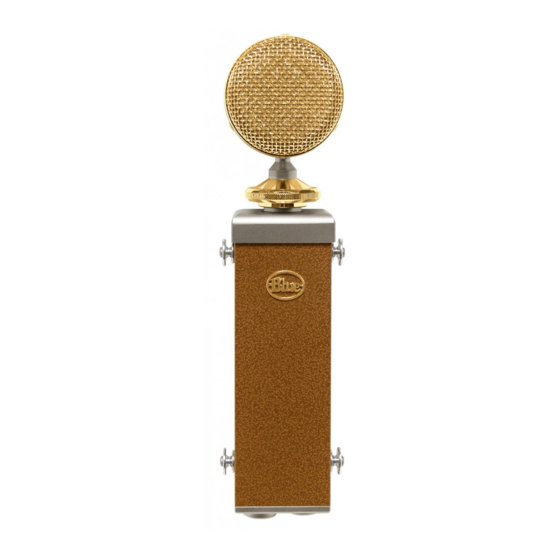Blue Cactus Gebruikershandleiding - Pagina 5
Blader online of download pdf Gebruikershandleiding voor {categorie_naam} Blue Cactus. Blue Cactus 9 pagina's. Blue microphones cactus microphones: supplementary guide
Ook voor Blue Cactus: Gebruikershandleiding (6 pagina's)

Recording Applications
Vocals
Here's a little-known secret—vocalists love singing into unique and
impressive mics. And in addition to its classic styling, the Cactus
was developed especially to enhance the projection, air, and mid-
range detail in a voice, while diminishing the proximity-induced
lows which can cloud a mix or produce compression artifacts. Put
it in front of any singer and you are guaranteed to get a 110%
inspired performance that sits perfectly in the mix with little or no
additional equalization. The Cactus is also outstanding for narra-
tion and voice-over work.
For a "big" vocal sound with maximum presence, get the vocalist
within one to three inches of the capsule. There is no need to
worry about overloading the microphone, but be sure to use
The Pop, universal pop filter (sold separately), to protect
the diaphragm at close distances. Tilt the Cactus up (toward the
forehead) for more projection and head tone, straight on at
the mouth for maximum brightness and intelligibility, or down
toward the chest for more robust lows and smoother highs.
Conventional vocal recording is almost always done using a cardi-
oid pickup pattern. But the variable pattern control on the Power
Stream power supply allows you to experiment with the timbre
changes which occur in subcardioid (left of center on the pattern
switch, towards omnidirectional) and supercardioid (right of cen-
ter, towards figure of eight) settings. Whenever possible, set up
the power supply in the control room, and spend a few moments
exploring these tonal shifts while "tuning" the pickup patterns.
The figure of eight pattern is useful for recording two singers on
one mic, or for a "hotter" solo vocal with increased proximity
effect (i.e. a typical radio announcer voice). The omnidirectional
pattern on the Cactus can also be put to unique effect, whether
recording a roomy, distant vocal track, capturing an unusual room
ambience in combination with a close vocal mic, or on large
group vocals.
Acoustic Guitar
For a balanced sound with plenty of sparkling high end, position
the Cactus facing the guitar neck, right where the neck joins the
body (usually around the 12th-14th frets). For starters, use the
cardioid pattern, keep the capsule as close as possible, and angle
it toward the sound hole to capture a blend of low end and pick
sound. If you need more lows, move the capsule closer to the
sound hole, or adjust the pickup pattern one click at a time toward
the figure of eight position. For more high end detail, move the
Cactus farther from the guitar, either at the same neck position,
or above the instrument up by the guitarist's head. An omnidirec-
tional pattern setting allows very close placement to the sound
hole without boomy lows, and distant placement to three feet or
more can produce interesting results throughout the available
range of pickup patterns.
Electric guitar
The Cactus B7 capsule is useful for any clean amp sound, rang-
ing from bright rhythm chords to warm jazzy tones. Angle the
capsule toward the center of the speaker to capture more highs,
or turn it toward the edge of the cone for a fuller sound with more
low end. The tube circuitry and natural high end response of the
Cactus is also excellent for overdriven and distorted amp tones.
To add a little room sound and/or soften the extreme high end,
move the mic towards the outer edge of the cone, or back it away
from the amp a foot or more.
For even more control over definition and room tone on electric
guitar tracks, it is common practice to use an ambient room mic
in addition to a close mic on the amp. The omnidirectional or
figure of eight paterns on the Cactus are highly recommended for
distant room miking applications on any amplified instruments,
including bass, organ, and blues harmonica.
Piano
Pop and jazz piano recording is usually accomplished with a
pair of microphones places inside a grand piano, either close to
the hammers for a defined, percussive sound, or roughly in the
